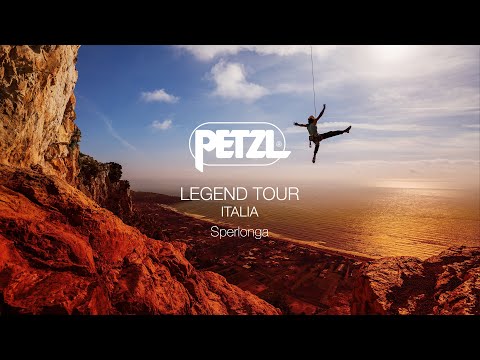Petzl Legend Tour Italia - Sperlonga

Sperlonga is the result of a dream a dream suspended between the sky and the sea. Starting from the 80s the heroic and romantic mentality of alpinism makes way to the search for new challenges: harder grades. Stefano Finocchi, Andrea Di Bari, Bruno Vitale together with Furio Pennisi, Enrico Jovane and Roberto Ciato are the ones who wrote the history of this magical place.
About Sperlonga... We started to hear at the Youth Italian Alpine Club namely, ESCAI we heard there was a crag close to Sperlonga past the four galleries. It was a huge, impressive wall where Fabio Delisi and his friends opened a route called “Picchiami sulle Bolle” so I went there.
We woke up one day and went to see Sperlonga, to see this crag. When we got to the place we were amazed by the quality of the rock, by the location itself because it is truly beautiful and by the vast range of possibilities lying ahead of us. It is there that our obsession started. It was a place meant to become a climbing destination with routes that seemed extreme in the past where we could climb on 8a, an impossible grade back then. - Originally routes were set from below it was inconceivable to do the opposite.
So when did the revolution start? - The point is we all came from an alpinism-based background therefore we learned to bolt routes from the bottom reaching from below the hypothetical summit, even though we can’t really talk about summits here, they are more like plateaus, as Gianpiero would say. All routes were set from the bottom: even routes of 20 or 30 meters took entire days to be completed not to mention how badly the protections were set. This was the way until Paolo Caruso and Marco Forcatura until Paolo Caruso and Marco Forcatura started the revolution: they rappelled themselves down placing an anchor and then fixing lead bolts - It’s also worth mentioning these bolts used to be placed by hand! - Yes, you had to place them manually and that involved hitting your fingers a lot with the hammer and cursing loudly. It was fun but painful at the same time.
Then electric tools came along! - Do you remember your very first electric drill? I bought it with Andrea, we split the cost. This was a sort of tradition we had which started when we split our first rope with two more friends paying 12.500 lire each. - And it’s because of that rope that you shared every step of your climbing path! - Yes, most likely, yes. And when we bought the drill… That was a real game-changer! We felt invincible against nature but with time we realized it was not really true.
- We will begin with the Chiromante wall! - The wall where the first Italian 7a was set? - Yes, exactly: "Kajagoogoo". It's wonderful here! With Stefano, my best climbing partner at the time we had a feeling of what was about to happen. We traveled to northern Italy and realized that we had to start to use lead bolts. Slowly but surely, we set “Flippaut” we bolted "Flippaut" but it was scary.
There was this impressive slab, which was just a 6a+ slab, but all we wanted was to push our limits. It was a leap into the unknown. We fixed 3 or 4 lead bolts, neither of us wanted to go first so we flipped a coin and I climbed first. I nervously climbed this 6a/6a+ slab I took some rests because I was afraid, not because it was hard.
When we reached the top we realized that just like the Zen masters say we had to let the bottom of the bucket fall out to be able to look beyond. From there we started to use bolts systematically. - Of course. You bolted "Kajagoogoo" with Stefano.
- Stefano bolted "Kajagoogoo". I don’t remember if I belayed him. Then I had an accident I fell down the stairs of my home so I had to take a break for 2 or 3 months. In the meantime, Stefano did a wonderful job, he made the first ascent and that was the first 7a.
The Chiromante wall was dedicated to Guido owner of a nearby restaurant. There and in the upper sector is where some of the most iconic routes were set and where the high-grade revolution started. The music from the Clash, the Cure the Police, Genesis was the soundtrack of the rides along the Via Appia and of the vertical dreams of this climbing community. I’ve always liked music and I still do. I listen to it a lot.
Listening to the Cure, Depeche Mode yes, it was my soundtrack. - Route naming has always been a tricky matter: one wants to express his own personality through the names of the routes. - Exactly, that is certainly true. To name a route means to shape its character think of “Ricordo del Tempo” (memory of time), “Metamorfosi (metamorphosis)”, or “Polvere di Stelle” (Stardust). Good job! I made the first ascend of “Polvere di Stelle”. My memories are fading, but I’m sure I was the one to do it.
There were some movements of the left foot that were not allowed because they made the route easier. If you completed it without them the grade was 7b, 7b+. When Martin Scheel tried it on sight he fell and said, “that is a hell of a 7c!” But you better not use that left foot! - The eternal grade dilemma! Just before sunset we travel on the ancient Via Flacca the historical road that connects Gaeta to Sperlonga and reaches Pilastro di Ponente, a true climbing oasis.
The sight of these routes is incredible. - One pitch! Let's climb one pitch! - Hey! So good to see you! - Can I join you? - Of course! Maybe for an easy one. - Would you like to belay Laura? - Sure! - That's great, you will belay me! Perfect! We will climb our last pitch in the sunset then. - How did the past few days go? - Very well! Today we went to the Chiromante wall and then to the upper section to see the historic routes. - A full immersion in history! I used to travel a lot to Finale Ligure, I was in love with that place. I became friends with Andrea Gallo and Giova Massari.
Andrea frequently hosted me when I visited him I learned a lot. There I've seen the Trussier brothers climb, I've seen Berhault climbing incredible routes. I invited Andrea and Giova here, they were super strong definitely much stronger than us at the time. They sent "Kajagoogoo" on sight then made the first ascent of “Reggae per Maometto” a route considered 7b+ now, but back then used to be 7a+. - It is definitely a challenging grade! - You had the chance to see it yourself yesterday! Then “Polvere di Stelle”, the first 7b… That was the spark that changed everything. To me personally it was also Andrea and Giova’s generosity: Giova gave me one of his fingerboards.
He saw I was looking at them curiously while they were training so he gave me one. Andrea gifted me with a training method. He asked me about my training routine which was mainly pull-ups, sometimes with weights and then he shared his training plan.
I still have the piece of paper where I wrote his instructions. Thanks to those gifts, my performance improved a lot! - Of course! An endless dream with shades of blue and grey that is how Sperlonga is described. - It’s always been a dream and it still is because climbing itself and those routes always bring back something to mind. There is a sort of romantic view of climbing associated with this place. From time to time you have to leave that romantic idea to go back to reality but then again those shades of grey and the blue of the sea.. - Coffee is ready! - Great, let's go! Let's drink this coffee and let's go! - Make sure you have enough to eat.
we're climbing a long route today! We will spend a lot of time on the wall. - That's why I'm bringing some nuts! - Good idea! - Should I pour your coffee here? - Yes, please. - Today's route overlooks the sea.
- Like the one we climbed yesterday? - No, it will be different we will be much more exposed. - Is it where Seve was drilling yesterday? - No, no it’s on a very steep cliff. - We will feel the void beneath us! - Yes, it’s going to be pretty steep.
Is it a problem for you? - No, not at all! - Perfect, we are gonna have a great time then. - We are gonna have fun! Cheers! The promontory of Gaeta and particularly Mount Orlando represent another milestone in the vertical history of central Italy. Everybody refers to it as “La Montagna Spaccata" (the Split Mountain) our destination is the exposed crux of “Croce del Sud” a sport climbing route with over 100 meters of pure vertical pleasure. Wow, it's spectacular! It's so beautiful! - Did you like the route, Wafaa? - Yes, it’s spectacular! - It was worth the effort! - Yes, the overhang was especially beautiful. - This is a truly magical place.
Andrea, Gaeta is the place, isn't it? - It’s a little hidden paradise, with its colors, smells, the void, the rocks. - There she is! - How was it? - Great! The seagulls kept me company. - They were quite loud, weren't they? - They were flying really close! - Well then! - Another route checked off! - I'm happy the weather didn't change.
- Listen, was this one more difficult than "Il Pesce"? - Good question, I'd have to think about it. It's been a while since I climbed that one! - Hold on, that car is moving closer. - You know how it is.. there are some crazy drivers over here! - Yes, let’s try not to end up with car scratches! We actually took the wrong way. We need to turn around, damn it. - We need to make a U-turn.
- We will turn around now. - Here? In the middle of the road? - Are we going to Jolly’s climbing gym? - Yep! He’s quite a character. - I can believe it, especially after what you read in his book. I can’t wait to meet him! In 300 meters, turn left on via dell'Ara Massima di Ercole, then turn left on via del Circo Massimo.
Another climbing legend of the 80s is Alessandro “Jolly” Lamberti. They call him "Jolly" because he can climb anything and there's no better place to meet him than beneath his temple: the campus board. I don’t think I was a pioneer back then.
I was there, I was certainly one of the strongest climbers, I even set some of the hardest routes out there but I was not a pioneer, as I didn’t bring any innovation or new trends. I was more of a witness. The one who was really a pioneer and started the revolution was Stefano Finocchi. He always anticipated trends. In the early 80s he already traveled around on a van with his dog when climbers still didn’t do that, he was the first to wear leggings. He even influenced us on the music we were listening to! - Music covered an important role.
If we think about route names such as “Kajagoogoo”. - Exactly! That's because if you are looking for the real pioneer of that time that would be Stefano Finocchi. - What was so special about this group of climbers? - It was definitely a group of kids who could spend a lot of their time climbing. No one climbed that much back then.
Many of us went to university or pretended to do so and went climbing instead. It was a lucky movement that started with the evolution of sport climbing. We used to climb on Mount Civetta, or Marmolada in northern Italy but at the end of the day we realized that it was not enough.
We liked it but we wanted more, we needed more. That is when we started to look for new challenges on shorter routes, rediscovering crags. To me that marked the end of the old idea of alpinism and the beginning of a new, explosive climbing style. The new climbing shoes with the sticky "spanish rubber" and especially the improvement of protections with the discovery of lead bolts, just like pitons in the 60s, made it possible to climb everywhere! The idea of rappelling yourself down fix the bolts, and finally try to climb the route was a huge breakthrough.
- In your book, you talk about “Ricordo del Tempo” your first tough route where you couldn’t even lift your feet off the ground. The real revolution was to be able to push your mental limits and to be able to climb walls that seemed too smooth to be climbed. I found that paragraph fascinating. - That was for two reasons: first because the climbing scene here in Rome has always been very competitive.
In the early 80s all we cared about were grades. The route could be ugly, short, or with terrible features but the grade was all that mattered. That and to be able to climb it before anyone else. “Ricordo del Tempo” was the hardest route, bolted by Stefano Finocchi, who was my friend but had to leave for military service for a year. I would never do it again but during that time I was opportunistic enough to try it and be able to top a grade that would make history. As I said, competition in the 80s was the real fuel.
We are now reaching the most remote and impressive destination of our journey. “Il Tempio” is a small vertical gem suspended over the summit of Monte Vanellamare. This route is a jewel you discovered by chance! - Yes, I would say “Il Tempio” is... - It's a small...
- A small hidden treasure. I was swimming in the sea when suddenly I saw this beautiful overhang. It was not easy to find it later, it was not easy to approach, you couldn’t see it from the summit. What fascinated me the most was how beautiful the view was, it’s pure magic. - Back in ’87, that was a visionary project! - We were looking for hard grades and were lucky enough to find 8a, 7b, 7b+.
Those routes became the most beautiful and iconic. But the real magic was just to be there to spend a whole climbing day there possibly with just a couple of selected people. - The right ones! “Il Tempio” has been abandoned for decades. Severino "Seve" Scassa another sport climbing legend, has joined us to go back to Sperlonga, visit his old friends, and to leave his mark: he replaced the bolts of 4 historical itineraries of this area. I called it “Il Tempio” (the Temple) because there was some sort of strong energy, with hawks flying around us and the absolute isolation from the city life and everything else.
You really felt in an outer world, over there. Federica is the first climber making her way up this route in 30 years topping the 8a that marked the history of Sperlonga: "Sacrilegio". Some workmen were reconstructing the galleries. As they saw us they told us a goat had escaped a few days earlier and could not find its way back as the trail was too dangerous. Initially, we didn’t care that much about it, but later we decided we had to do something. With our descenders and ropes we began our goat rescue operation.
We managed to rescue it and realized that instead of rappelling down the hideous wall we could easily reach the route from a ledge. That ledge was discovered by a shepherd because apparently his goats got stuck there frequently. This is the story of “Il Tempio”.
The strength of our climbing community was simply teamwork: Andrea and I set hard routes while Bruno took care of the easier ones more accessible to everybody. This meant more and more people started to climb here attracted by the location itself, by the sea. Consider that even in January and February the weather is really warm. Imagine us as teenagers, young and tanned climbing in the sun on all sorts of routes, hard and easy.
It was a vibrant environment. From Sant’Agostino plain our vertical journey continues towards a magnificent overhang in the heart of Mount Moneta. Its red roofs tell us another piece of the climbing history in Rome. This is where throughout the 80s the overhang heroes challenged themselves. I’m an overhang fan and on Mount Moneta there was this beautiful line. The first pitch was a 7c+ and ended at the bottom of a roof.
I realized that even on that horizontal roof it was possible to climb so I fixed some bolts and gave it a try. I repeated the whole sequence from the bottom and the rest is history. - Hi there! How's it going? - Very well, thanks. We are enjoying our time here. - Is it warmer today? - Today it's perfect! The best day so far. - This is for you and Seve.
- Thanks, how are you? - I can't complain! I've climbed over there for a couple of hours. - He replaced the bolts on "Il Tempio"! - So I've heard! Did you like it here? Are you going back? - Yes, we've also been to the "Montagna Spaccata" yesterday: beautiful! - Did you climb there? - Yes, we climbed "Croce del Sud", it was amazing. - Historically, there were "Hellzapoppin" and "Croce del Sud". "Croce del Sud" is basically another version of "Spider Man" but bolted from above. The old and the new overlap. - “Spider Man” is the route set by Manolo in 1977. - Right! Then there is “Pietro Ferraris” over there.
- You set that one! - Yes, and no one wanted to join us! Because the approach was too long. They thought we were crazy to go to Mount Moneta. - "Why would you go there, with such a long approach?" - But finally, we set this route. It took us 12 entire Sundays. Even longer than what it took the Austrians to climb Sugarloaf in Rio de Janeiro. What's happening here? Do women fall from the sky over here? Hi there, I'm Bruno nice to meet you! Here there are huge overhangs, like the one in front of us.
You set the first route here. - The thing is, the previous generations of alpinists used to climb on cracks, dihedrals, or chimneys because they were easier to reach. Over here, the protections couldn't be placed easily. - Of course. The experience of that generation was influenced by the previous ones. When we were young we thought we were invincible, better than anyone else.
But in reality we were also influenced by those who came before us. Every generation learns something from the previous ones. Our generation was very strong.
I was a lucky witness of those climbers who solved the issue of climbing on slabs and later on, moved on to climbing on overhangs. When we came here to Mount Moneta we set a route the classic alpinist way then Andrea came over and free climbed the first pitch. From that moment the heroes of overhang started to explore routes and pitches that would have been inconceivable just a few years earlier. There is one person in particular, and you've met him Patrick Berhault whose climbing style has influenced route setting also here in Sperlonga. The point is all of us had an idol, you know? I immediately felt a connection with Berhault. Maybe it's because we both had long hair, I don't know! I loved that he climbed on overhangs.
I’ve always liked them, I find them fascinating. I was not even close to his level but sometimes destiny surprises you. When I was young I hung pictures of him in my bedroom, years later there he was sleeping in that same bedroom surrounded by his own pictures.
It’s a beautiful story. I had the chance to climb with Berhault here in Sperlonga and in the Ciampino Caves where I brought him as soon as he arrived. He’s been a great influence on me. - Can I go? - Go! - So cool! - What is climbing for you today? - Climbing is one of the many loves of my life. First, because I like it and I continue to climb then because I think you should never quit doing what you love, as long as you can. I’ve been climbing for 41 year and I’ll try to keep going as much as I can.
It’s been a constant in my life and it’s important to me. Sometimes when I feel a little down, tired, or stressed you know, those things that happen in life I know that even just half a day of climbing with the right person, with the right people is enough to recharge, it really makes a difference. When I go back home I feel like I washed my worries away. It helps a lot. - Do you regret anything? - Yes, for sure.
- Related to climbing, is there anything you'd change? - Yes, I can think of many things related to climbing. For example, the fact that I never finished my studies. That was because of climbing. I was obsessed with climbing.
But the truth is I could have easily done both at the same time. As for missed climbing goals, “Action Direct” is definitely the one. I was very close to send it in 1999/2000. I thought I knew how to do it. Yes, that's probably my biggest...
- Your vertical regret. - Yes, a dream I think I will never fulfill. - Never say never! - What is the role of climbing in your life? - It is certainly something very important and beautiful. It encouraged me to live fully. Do you live to work or work to live? To me, that is the point. Climbing is important to me because it taught me how to live and to live passionately and fully.
You always have to look for something that excites you because if you don’t then you wouldn’t enjoy your time here. We are here to live our lives to their fullest. What a wonderful light! Absolutely beautiful!
2021-04-28 17:11


